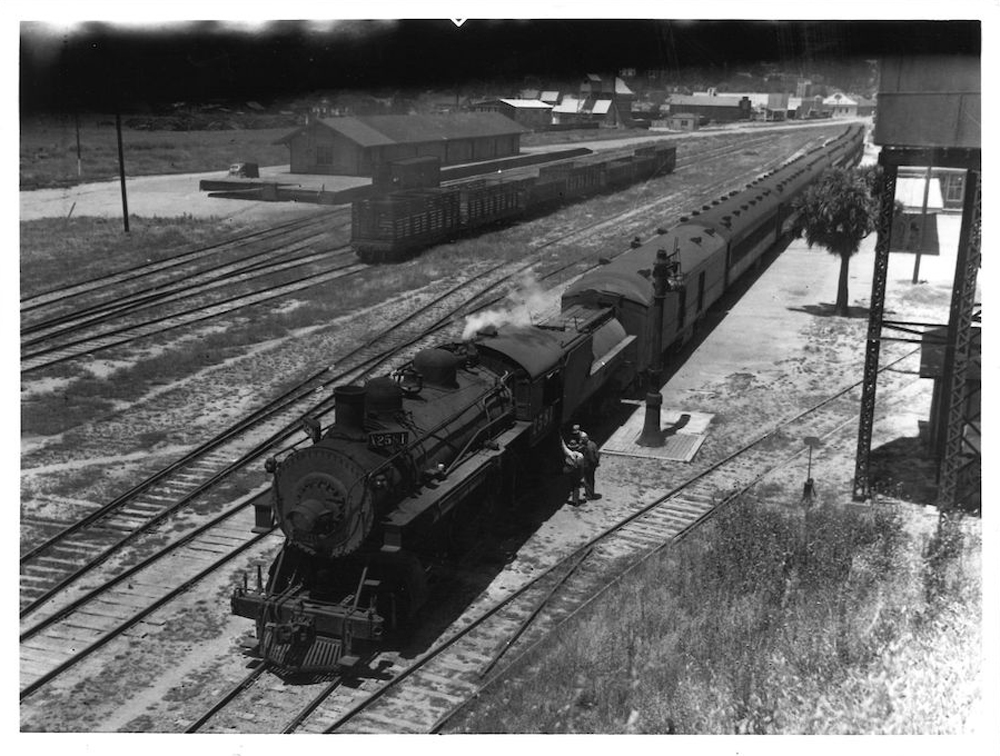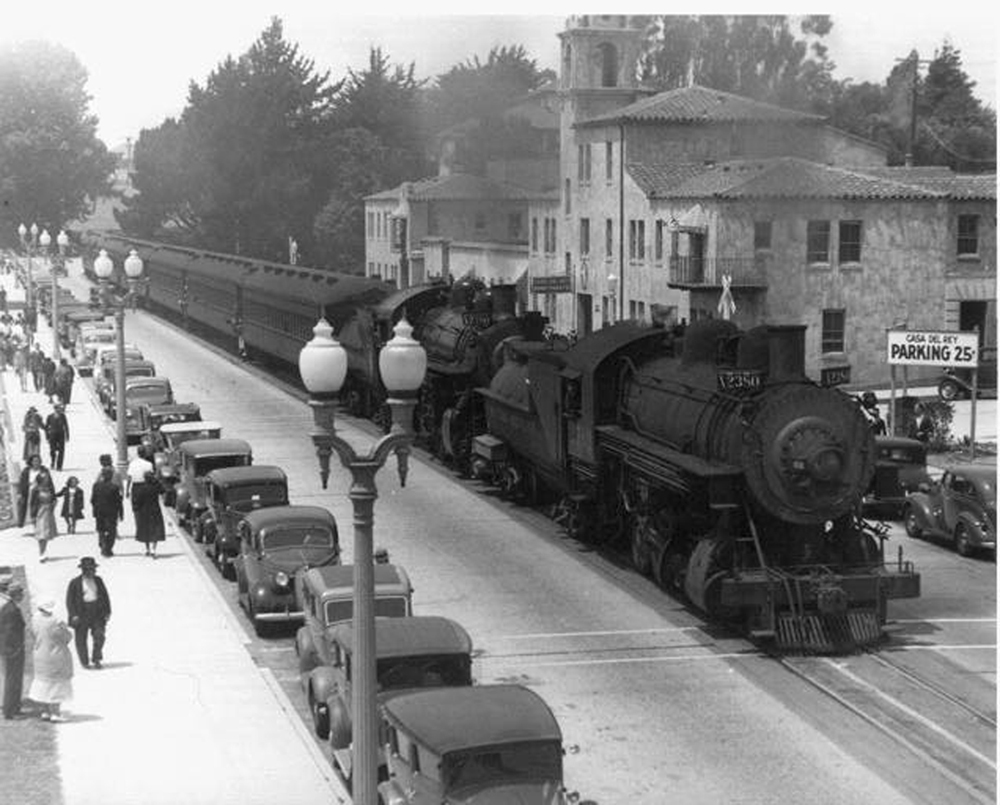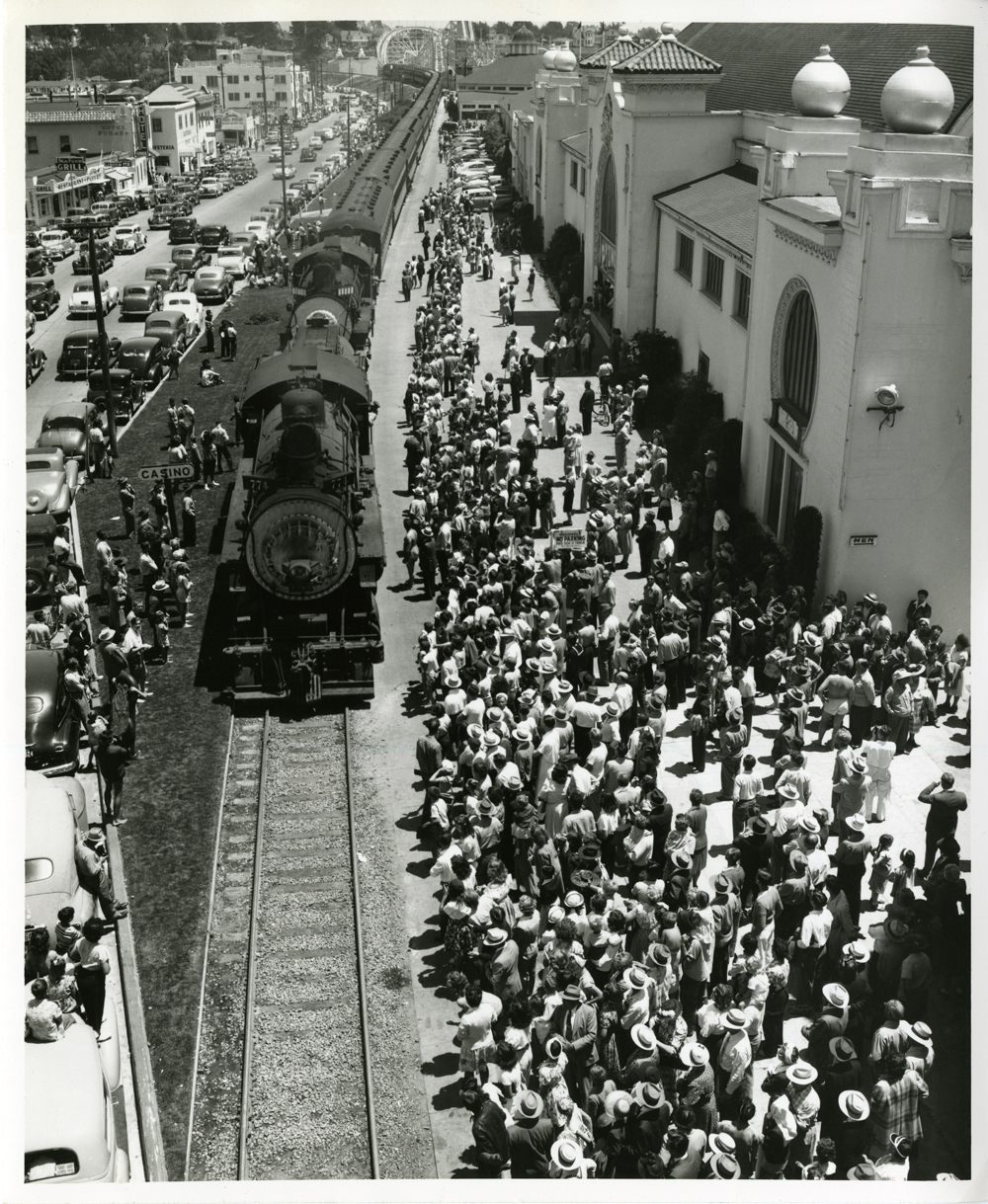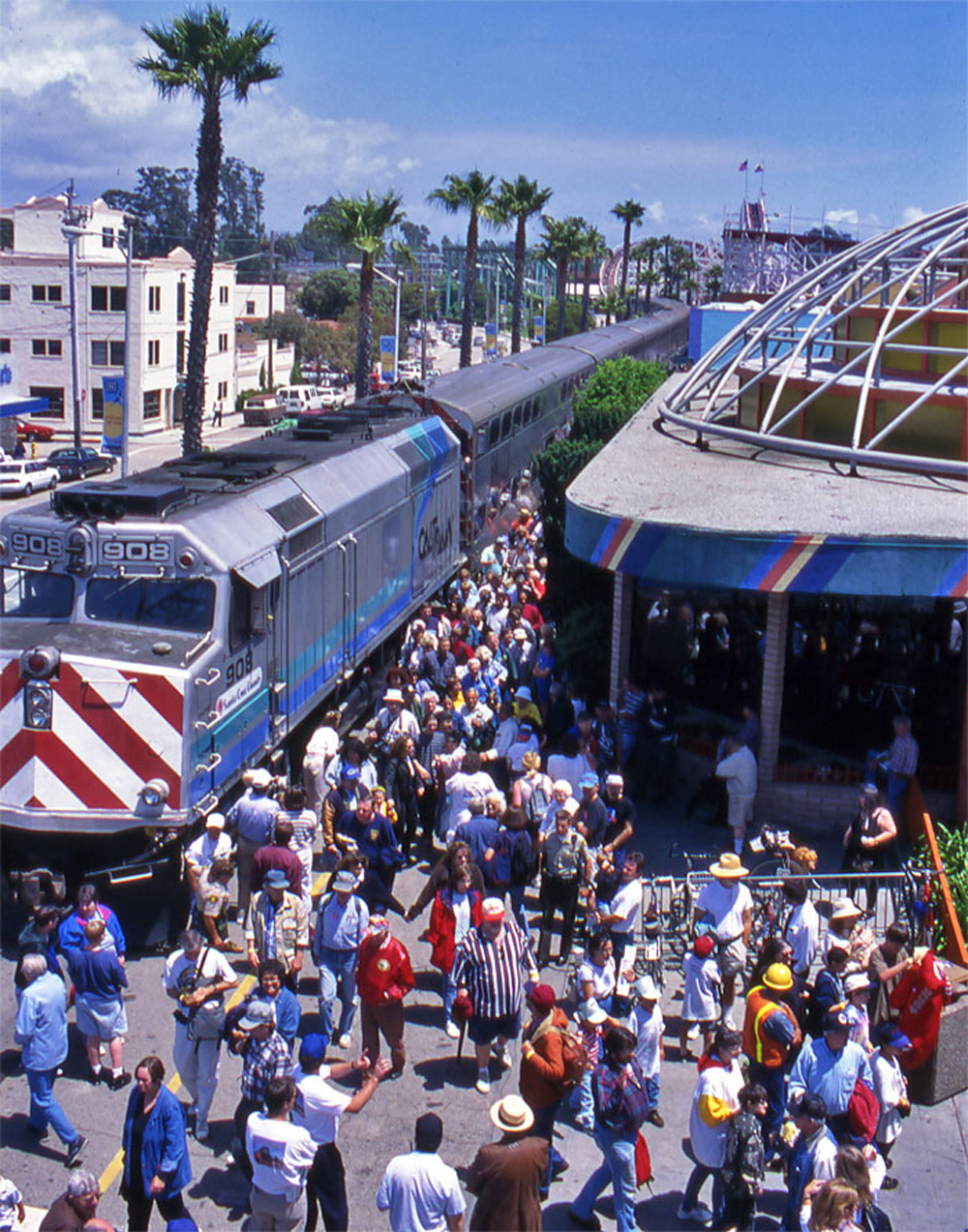Sun Tan Special

People in Santa Cruz, Calif., still talk about the Sun Tan Special, and not just as an artifact. The Sun Tan Special was Southern Pacific’s beach train in Northern California. It ran on summer weekends and holidays during the 1930s to the 1950s, from San Francisco and San Jose to the coastal town of Santa Cruz.
The destination was appealing, the views were great, and the mood onboard was primed for fun. “Life on the Sun Tan Special was an exciting affair,” writes Santa Cruz Railroad historian Derek R. Whaley in “Curiosities: The Sun Tan Special” on santacruztrains.com. “Everyone was dressed for the beach.”
More than 60 years after SP canceled the train, the memory of its success, and its potential as an alternative to driving, sustain it as an idea. The Sun Tan Special was most recently a talking point during a June 2022 local election in Santa Cruz County, when a ballot measure asked voters what they wanted to do with the last railroad line into the county, a former SP branch off the Coast Line from Watsonville Junction (Pajaro) to Santa Cruz city and Davenport. The choice was trail, or rail with trail.
The voters were clear: Keep the tracks. Rail with trail won by 73% to 27%, even though the branch is mostly idle north of Watsonville, damaged in places, and needs repairs that would cost tens of millions of dollars.
The odds that the excursion train will return are hard to assess but probably modest, based on the complexity of the goal and the record of the past few decades. The odds that a passenger service will return to Santa Cruz are better.
Regardless, thanks to Roaring Camp Railroads, an enterprising tourist railroad company and park in the Santa Cruz Mountains, it’s possible even now to sample a bit of the Sun Tan Special experience.
Double-header territory

The Sun Tan Special used single-level coaches borrowed from the SP’s weekday Peninsula commute fleet. Food carts offered snacks and coffee, an open-ended observation car brought up the rear, and the Cocoanut Grove band played as riders stepped off at the Santa Cruz Boardwalk at the beach.
Conceived as a one-time experiment in July 1927, the train was an immediate hit. The service expanded during the next few years and acquired its name in 1930. Sun Tan Special, Whaley writes, evoked the beach, suntan lotion, the initial schedule of operating on Sundays (Saturday trains came later), and the Sunset Route, one of SP’s most popular transcontinental excursions.
Trains went to the coast in the morning and returned the same evening. Some trains began or ended in Oakland, the city across the bay from San Francisco. The full trip took about 3 to 3½ hours each way, depending on the route.
The Sun Tan Special originally ran from the Bay Area through Los Gatos on SP’s line into the Santa Cruz Mountains, passing through Alma, Glenwood, and Felton. On operating days in the mid to late 1930s, Whaley writes, “up to seven trains ran each direction in summer months, all … led by two locomotives to overcome the steep and twisting terrain of the Santa Cruz Mountains and specifically San Lorenzo Gorge.”
A severe storm in February 1940 hammered the line, prompting the SP to remove the tracks between Los Gatos and Olympia, just uphill from Felton. The railroad moved the Sun Tan Special to the route via Watsonville. Passengers lost the mountain scenery but gained views of the Monterey Bay, and the train remained popular.
Suspended during World War II, the service roared back in 1947. Some trains exceeded 20 cars. At Pajaro, Whaley writes, “the train would lose its high-efficiency locomotive and be replaced with two nimble Consolidation engines that could handle the hills and curves of the Santa Cruz coast.”
The service ended for the usual reasons. Roads got better, the public shifted to driving, and SP soured on passengers. SP discontinued the Sun Tan Special after September 1959. Passenger charters used the line until 1965. Then SP downgraded the branch to freight only.

Enter UP, plus a brief return in 1996

The train went away, but the beach and coast stayed attractive, and the Bay Area kept growing. The region’s population hit 7.8 million in 2020, more than twice what it was in 1960. The roads grew congested. Before the 1960s ended, planners were looking for other ways to handle the traffic.
Some people have even proposed rebuilding a route through the mountains, but opposition by property owners and the projected expense have blocked the idea. The main goal now is to offer local or regional service for commuters and other passengers, maybe with something like the Sun Tan Special as part of the mix.
The Union Pacific, shortly after acquiring the SP, let Caltrain and Amtrak operate two demonstration trains between San Jose and Santa Cruz in May 1996. They were billed as “the return of the Sun Tan Special.” A third demonstration train on the branch, the “Coastal Cruzer” in August 1996, used Amtrak IC3 Flexliner trainsets.
Union Pacific wasn’t interested in further revivals but was willing to sell the branch. The last major shipper north of Watsonville was a cement plant in Davenport that shut in 2010. In 2012, the Santa Cruz Regional Transportation Commission (RTC) bought the 32-mile Santa Cruz Branch from the UP with the intent of restoring passenger trains.
The revival hasn’t happened, at least not yet.
Santa Cruz railroads today
Since 2012, three shortline companies have contracted with the RTC to operate trains on the branch. The second of the three, Iowa Pacific’s Santa Cruz and Monterey Bay, did operate Christmas excursion trains on the line in the 2010s.
Roaring Camp has a subcontract with the current contractor, Progressive Rail, to serve freight customers in Watsonville on the active southern part of the line. Damage and erosion north of there have closed the branch as a through route.
Roaring Camp is “in charge of freight across the entire line, although for practical purposes they are restricted to the Watsonville area until the rest of the trackage is approved for passenger and freight service,” Whaley told Trains. “[That’s] not likely anytime soon, since the Soquel Creek Bridge needs either very expensive upgrades or, more likely, to be replaced completely.”
The 585-foot bridge in Capitola is one of the line’s landmarks.
The pro-train vote in June 2022 helped reinforce public support for local rail transit and pushed back against efforts to remove the tracks as relics not worth repairing.
As of autumn 2022, the RTC is taking steps to repair a bridge on the Pajaro River and address erosion, plus take a fresh look at what would be needed to bring light-rail electric passenger trains to the line.
Parts of the branch are intact enough to use. In October 2021, California streetcar company TIG/m, Roaring Camp, and others teamed up to offer the public free rides on wireless electric trolleys in Watsonville and between Capitola and Santa Cruz on the branch.
This Coast Futura demonstration, said Roaring Camp Chief Executive Officer Melani Clark in early 2022, showed what’s possible on the line. She is a leading proponent for repairing and restoring the track for use by trains.
The RTC “is once again moving forward with exploring electric passenger rail transit on the Santa Cruz Branch Line,” Clark said in fall 2022. “While there are many studies to complete before [passenger transit] is active on the line, Roaring Camp is very grateful the RTC is moving forward in this positive direction.”
Riders could reach the Bay Area by connecting to other trains in Pajaro, she said. “Travel beyond Santa Cruz is looking very promising via the RTC’s future [service] that will connect in Pajaro to Caltrain and the Coast Starlight.”
The Coast Starlight, Amtrak’s daily train between Los Angeles and Seattle, currently passes Pajaro without stopping. The closest stop is in Salinas. Caltrain, the Bay Area commuter service from San Francisco to Gilroy, could serve Pajaro if Caltrain extends its trains to Salinas. Proposals to do that are in the works. The extension would use more of the UP’s Coast Line, so the railroad would have to approve the use.
The gorge, a tunnel, and street running in 2022
The stub of the Sun Tan Special’s original mountain route survives as the Felton Branch. Southern Pacific sold it to Roaring Camp Railroads in the mid-1980s. The company’s Santa Cruz Big Trees & Pacific Railway uses ex-Santa Fe CF7s to pull passenger trains between the Santa Cruz Boardwalk and Felton, where the Roaring Camp and Big Trees tourist railroad offers rides over a steep narrow-gauge line into the redwoods.
Whatever happens next on the Santa Cruz Branch, you can get a sense of the Sun Tan Special by riding one of these Beach Trains. They follow 7 miles of the original route amid trees, across bridges, and through the San Lorenzo River Gorge and a tunnel. It includes street running in Santa Cruz.
The train uses a small part of the Santa Cruz Branch to access the Boardwalk, the same location where bands welcomed arriving passengers in the last century.
The Beach Train is far from the full Sun Tan Special experience, but it offers a lot of variety in those 7 miles. “The one part that really overlaps was the section between Santa Cruz and Henry Cowell [Redwoods State Park], which is the section still used by Roaring Camp today,” Whaley said.
“While I don’t think that 7-mile stretch necessarily gives a complete feel for what the Sun Tan Special would have been like,” he said, “it definitely gives a feel for one of the best and most photographed parts of the journey.”
Consider the Beach Train a tangible reminder of a fabled summer train. And, possibly, a link to whatever passenger service might come next to Santa Cruz County.














My family moved to Capitola when I was in junior high. The Sun Tan Special had stopped for about 10 years by then, but the freight service was still strong, running M-F. I lived close enough to the tracks to clearly hear the train horn as it passed by in the morning and evening return. The link in the article for the website didn’t open for me, but try this one. https://www.santacruztrains.com/2019/09/curiosities-sun-tan-special.html
There’s every possibility of the Sun Tan Special returning in some form or another.
The Coast Futura mentioned in this article stands as proof to the community that the rail line is viable and with repairs can be restored to useful condition for regular passenger service, special excursions, and freight.
Readers can learn more about Coast Futura here: http://www.coastfutura.org
Thank you for this article!